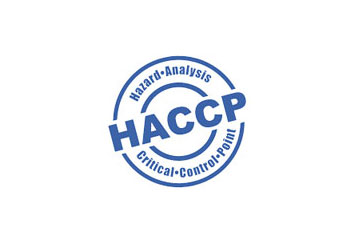
Hazard Analysis and Critical Control Point (HACCP) is an internationally recognized system for reducing the risk of safety hazards in food.
A HACCP System requires that potential hazards are identified and controlled at specific points in the process. This includes biological, chemical or physical hazards.Any company involved in the manufacturing, processing or handling of food products can use HACCP to minimize or eliminate food safety hazards in their product.
Guideline for application of HACCP Principles
 Introduction
Introduction Prerequisite Programs
Prerequisite Programs Education and Training
Education and Training Developing a HACCP Plan
Developing a HACCP Plan Assemble the HACCP team
Assemble the HACCP team Describe the food and its distribution
Describe the food and its distribution Describe the intended use and consumers of the food
Describe the intended use and consumers of the food Develop a flow diagram which describes the process
Develop a flow diagram which describes the process Verify the flow diagram
Verify the flow diagram Conduct a hazard analysis (Principle 1)
Conduct a hazard analysis (Principle 1) Determine critical control points (CCPs) (Principle 2)
Determine critical control points (CCPs) (Principle 2) Establish critical limits (Principle 3)
Establish critical limits (Principle 3) Establish monitoring procedures (Principle 4)
Establish monitoring procedures (Principle 4) Establish corrective actions (Principle 5)
Establish corrective actions (Principle 5) Establish verification procedures (Principle 6)
Establish verification procedures (Principle 6) Establish record-keeping and documentation procedures (Principle 7)
Establish record-keeping and documentation procedures (Principle 7) Sedex 2 Pillar / 4 Pillar / Smeta BPG Version 6.0
Sedex 2 Pillar / 4 Pillar / Smeta BPG Version 6.0 SA 8000 : 2014 Social Accountability
SA 8000 : 2014 Social Accountability Business Social Compliance Initiatives (BSCI)
Business Social Compliance Initiatives (BSCI) Worldwide Responsible Accredited Production (WRAP)
Worldwide Responsible Accredited Production (WRAP) Responsible Business Alliance (RBA)
Responsible Business Alliance (RBA) ISO 26000, SCA Compliance, CSR
ISO 26000, SCA Compliance, CSR ISO 9001 : 2015 Quality Management System
ISO 9001 : 2015 Quality Management System ISO 14001 : 2015 Environment Management System
ISO 14001 : 2015 Environment Management System ISO 45001 : 2018 Health & Safety
ISO 45001 : 2018 Health & Safety ISO 22000 : 2005 Food Safety
ISO 22000 : 2005 Food Safety Hazard Analysis Critical Control Point (HACCP)
Hazard Analysis Critical Control Point (HACCP) Process Safety
Process Safety